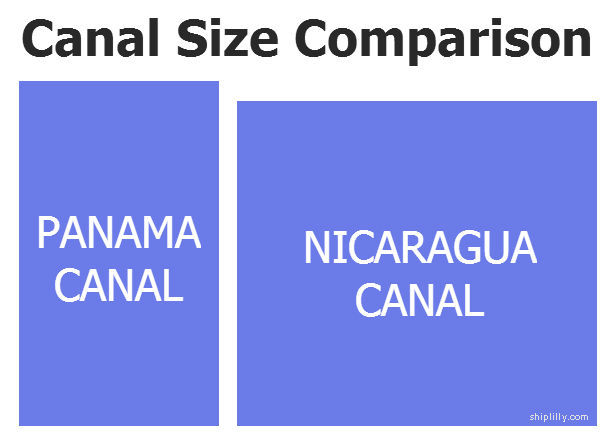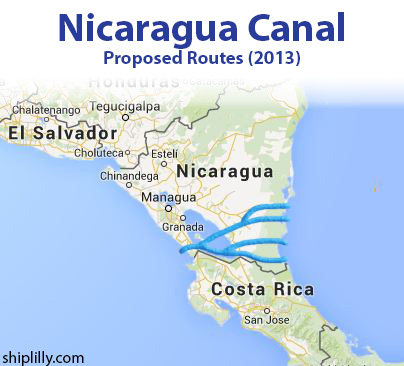As the Panama Canal expansion project struggles with delays and cost overruns, the planned Nicaragua Interoceanic Grand Canal is stepping into the spotlight.
The proposed Canal, which is backed by Chinese investors, is due to be completed in 2020 and will provide an alternative shipping route between the Atlantic and Pacific oceans (3). When finished, the Nicaragua Canal will be 72 feet wide and 65 feet deep, and will stretch 174 miles across Nicaragua (1).

It is estimated to cost $50 billion and will support jobs for 50,000 people. However, the Nicaragua Canal project is more than just another large-scale construction project. The Canal signifies a momentous change in the economic, environmental, and political situations in both Nicaragua and the world as a whole.
Economic Significance
If it is completed, the Canal has the potential to reenergize the Nicaraguan economy. The Nicaraguan government predicts that the Canal will raise the economic growth rate from a relatively low 4.5% to 14.6% by 2016 (5). Yet while it will benefit the country as a whole, individuals living in the planned path of the Canal, who are mostly poor farmers and native people, stand to lose their homes and land (2).

Photo Credit: Esteban Felix/AP
The government offered financial compensation, but it was not enough to stop a protest of the project on December 24th (2). The protest, which blocked a major highway, turned violent when police and protesters clashed (2). Accounts differ as to how many civilians and police were injured, but it seems unlikely that protests will be enough to stop the extremely lucrative project.
In the meantime, many questions have been raised about the Canal’s financial backing. The high cost of the project, which is four times the amount of Nicaragua’s GDP, in combination with the relatively short timetable have led to speculations that the Canal is funded by the Chinese government rather than by private Chinese businesses (4). It is unlikely that the Chinese government would acknowledge this, but it is undeniable that China and many other countries will benefit from the existence of the Nicaragua Canal (4).
Not only will the Canal allow for increased trade flow, it will also provide a route that is not under the control of the United States, which is both economically and strategically important.
Environmental Significance
The Canal, like any major construction project, raises concerns about the effect the project will have on the environment. The plans for the Canal show that it will pass through Lake Nicaragua, the country’s largest lake. Ecologists are concerned that the resulting ship traffic will seriously pollute the lake, which is also Nicaragua’s largest water source (3).

Photo Credit: ShipLilly.com
The planned route also passes through tropical rainforest and wetlands, including the Cerro Silva Natural Reserve (5). Several groups have issued complaints with the Nicaraguan government (5), but whether or not the government plans to address the potential environmental damage of the Canal is unclear.
Political Significance
Finally, the construction of the Canal represents a potential political shift; a country with control of an alternate trade route between the Atlantic and Pacific oceans holds a lot of power.
If the Chinese government is involved in the construction, the Nicaragua Canal will provide China significant influence in trade and Latin American politics (4). Russia is also reportedly involved in the construction of the Canal; although Russian shipping does not rely on an Atlantic-Pacific route as much as China does, the country can also benefit from a foothold in Latin America.
The presence of Chinese and Russian influence in Nicaragua is certainly not a thrilling concept to the United States government. Adrian Salbuchi, an Argentinian political analyst, theorizes that Barack Obama’s recent outreach to Cuba may have been an attempt to strengthen relationships in Latin America as a response to the Nicaragua Canal (3).
Overall, the Nicaraguan government has chosen to prioritize the improvement of their economy over the concerns of individual citizens and the environment, and will reap the financial rewards. Worldwide shipping will also benefit from the option of a new trade route. But how the construction of the Nicaragua Canal will affect the power relationships in the rest of the world remains to be seen.


One Comment on ““The Nicaragua Canal: Everything You Need to Know””
Kind Sir, For many years I have held that the Nica Canal was very important. I lived in Nicaragua and was made aware of the attempts to build The Canal. After I began to write and pray for a way to proceed, Wang Jeng offered the idea, which as you know has failed. My friend was instrumental to facilitate in the Contra-Sandinista ceasefire. He lives and works among the Miskito People. He would be most eager to help facilitate this endeavor. I believe the Canal can be built for a fraction of the proposed $50 billion. God Bless You.
I just wanted to say…. The Dream is Still Alive… Roger Marcus